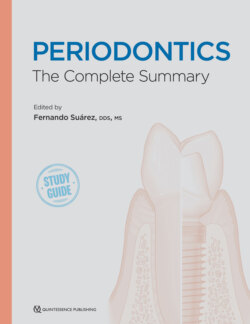Читать книгу Periodontics - Fernando Suarez - Страница 107
На сайте Литреса книга снята с продажи.
Palatal Exostosis (Tubercles)
ОглавлениеExostoses are defined as benign bone growth projections outward from the surface of a bone.1 Palatal exostoses are bony protuberances that can cause surface irregularities, leading to periodontal pockets in the area of maxillary molars. Larato proposed a classification based on their anatomical appearance as Type A (small nodule), Type B (large nodule), Type C (sharp ridge), Type D (spike-like projections), and Type E (combinations of types A to D).191
Several studies using human skull specimens have reported a diverse prevalence of palatal exostosis ranging between 30% and 56% (Table 5-11).191–193 These subtle differences might be influenced by ethnic background and/or age.192,193 Most of the palatal exostoses (62%) are commonly found in the maxillary third molar area and directly lateral to and at a mean of 11.4 mm from the greater palatine foramen.192 The removal of these bony protuberances is often indicated to ensure proper flap adaptation during resective procedures. These can also serve as a potential source of autogenous bone for regenerative procedures.192
TABLE 5-11 Prevalence of palatal exostosis
| Authors | Prevalence |
| Larato191 | Overall: 30%Population: Mexican |
| Nery et al193 | Overall: 40.5%Population: European, Oceanic-Asiatic, African, and Mexican-Peruvian |
| Sonnier et al192 | Overall: 56%Population: Caucasian and African American |
